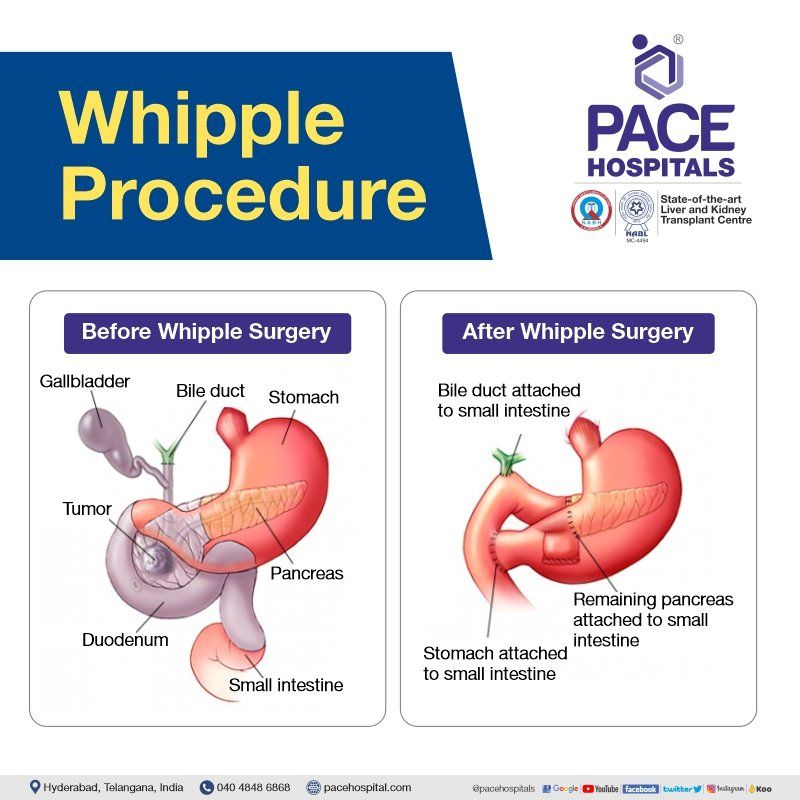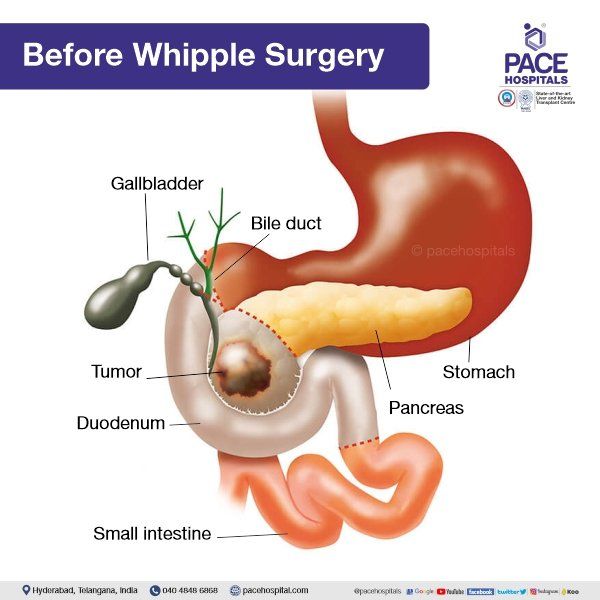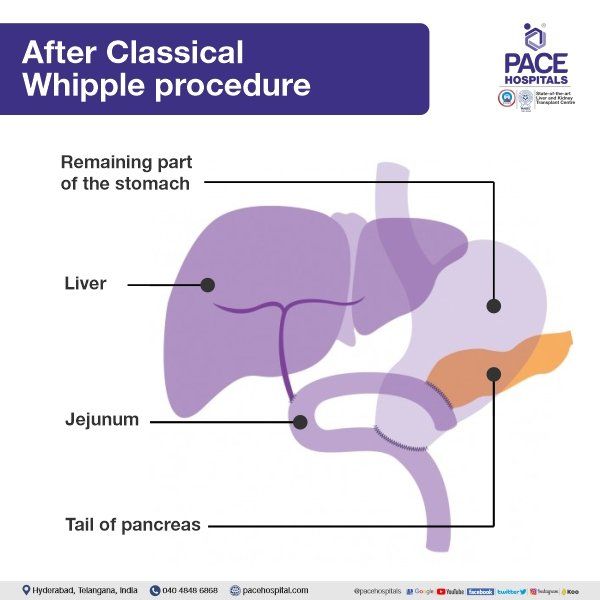Whipple Procedure - Pancreaticoduodenectomy | Surgery, Success & Cost
At PACE Hospitals, team of whipple surgery doctors - Surgical Gastroenterologists and HPB Transplant Surgeons are experienced in handling even the most complex and complicated cases of pancreatic cancer, ampullary cancer, bile duct cancer, duodenal cancer, and expertise in performing surgery with using AI surgical robotic system with high success rate.
-
Quick Links
Request an appointment for Whipple Surgery
Whipple Procedure - appointment
Thank you for contacting us. We will get back to you as soon as possible. Kindly save these contact details in your contacts to receive calls and messages:-
Appointment Desk: 04048486868
Whatsapp: 7842171717
Regards,
Pace Hospitals
Hitech City and Madinaguda
Hyderabad, Telangana, India.
Thank you for contacting us. We will get back to you as soon as possible. Kindly save these contact details in your contacts to receive calls and messages:-
Appointment Desk: 04048486868
Whatsapp: 7842171717
Regards,
Pace Hospitals
Hitech City and Madinaguda
Hyderabad, Telangana, India.
- Why choose us -
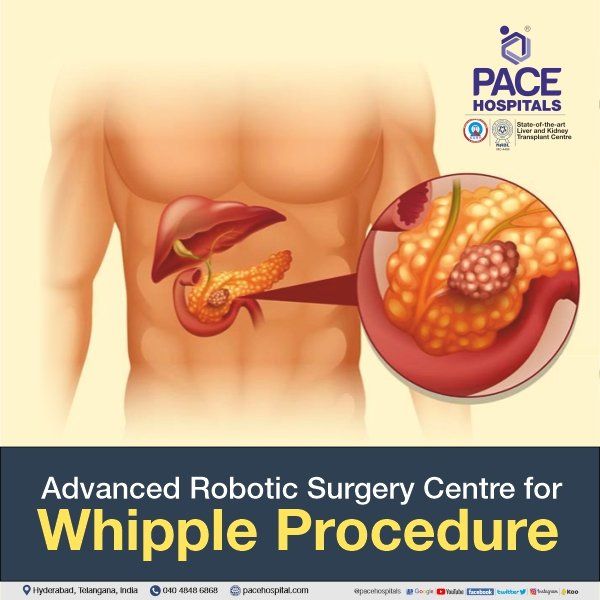
250+ Whipple Procedure for Pancreatic and Ampullary Cancer
Robotic Surgery Techniques for Precision Treatment with 99.9% success rate
Team of the best whipple surgery doctors with 30+ years of expertise
All insurance accepted with No-cost EMI option
What is Whipple Procedure?
Whipple procedure is a complex operation to remove the gallbladder, the head of the pancreas, the first part of the small intestine (duodenum) and divide the bile duct and reconstruct it.
Whipples procedure, also termed as pancreaticoduodenectomy, is a surgical procedure done to treat tumours and other disorders of the pancreas, the intestine and the bile duct. It is a complicated procedure primarily used to treat pancreatic cancer confined to the head of the pancreas, part of the adjacent small intestine called the duodenum, the common bile duct, and the gallbladder.
Whipple surgery is technically a complicated and high-risk procedure to carry out and the only option for pancreatic cancer. It is also lifesaving surgery for the patients with pancreatic and other cancers.
Types of Whipple Procedure
There are mainly two types of The Whipple procedure –
- The Classical or Conventional Whipple procedure (Pancreaticoduodenectomy)
- The Pylorus-preserving Whipple procedure (Pancreaticoduodenectomy)
The Classical or Conventional Whipple procedure: In this method the head of the pancreas, the gallbladder, a part of the bile duct, the duodenum, and a part of the stomach are removed and the remaining pancreas, stomach, and bile duct are then reconnected to the digestive system.
The Pylorus Preserving Whipple procedure: In this method the head of the pancreas, the gallbladder, a part of the bile duct, and a part of the duodenum, are removed and the pylorus is preserved (a part of the stomach that connects to the duodenum). Further remaining pancreas, stomach, and bile duct are then reconnected to the digestive system.
Why is the Whipple procedure needed?
Whipple procedure is needed in case of a patient suffering from a pancreatic, duodenum, or bile duct tumour. It is a complicated and risky procedure, but the only option for pancreatic cancer treatment.
The pancreas is one of the vital organs responsible for the digestion of food, especially fat and protein. It also releases the hormone "insulin" that helps manage blood sugar levels; hence, it is essential to treat the affected pancreas for better body function.
Some of the conditions a doctor can recommend going through Whipple surgery are:
- Pancreatic cancer
- Pancreatic cysts
- Pancreatic tumours
- Pancreatitis
- Ampullary cancer
- Bile duct cancer
- Neuroendocrine tumours
- Small bowel cancer
- Trauma to the pancreas or small intestine
- Other tumours or disorders involving the pancreas, duodenum or bile ducts
Who are idle patients and eligible for the Whipple Procedure?
For the Whipple surgery, ideal patients would be those whose tumour is limited to the top of the pancreas and has not spread to closely located blood vessels, the lungs, liver or abdominal cavity. Only 20 % of pancreatic cancer patients are acceptable for Whipple procedures and surgeries.
Whipple Procedure is not an option for 40 % of recently diagnosed patients whose tumour has spread beyond the pancreas. Still, some patients could be acceptable for a minimally invasive Whipple procedure with multiple small incisions.
Preparation and briefing before Whipple Procedure
How a patient is being prepared for surgery is based on the several reviews and evaluations of the diagnostic reports, and then patient is suggested which surgery approach would be suitable for him. The healthcare experts make sure of the health conditions and required test for the patient to further proceed with the surgery.
The briefing also includes the explanation by the surgeon on the scenario before and after the surgery, the risk factors, complications and the impact of the surgery on his family and life.
Sometimes the Whipple procedure or other pancreas operations such as distal pancreatectomy, partial pancreatectomy, total pancreatectomy, central pancreatectomy or subtotal pancreatectomy being performed for cancer is followed or preceded by radiation therapy, chemotherapy or both.
Based on the medical conditions and complications, Whipple surgery can be performed in three ways:
- Open Surgery: This is the most common way of performing the Whipple procedure. This is done by making incisions on the abdomen to perform surgery on the affected areas (around the pancreas).
- Laparoscopic Surgery: It is one of minimally invasive technique, in which many small incisions are made on the abdomen, through which camera attached instrument is inserted inside to transmit video feed, guiding the surgeon to perform the Whipple procedure effectively.
- Robotic Surgery: It is the advanced minimally invasive technique in which surgery is performed by robot equipped with surgical tool. The surgeon controls the activity of robots through console.
Minimally Invasive surgery has its own advantages which includes fewer incisions on body, less blood loss and quick recovery.
What should a patient expect before Whipple Surgery?
An intravenous line (IV) will be put in your arms before surgery to inject the fluid and medication into your veins as per requirement, and you may also get some medicines in case of your nervousness. You may also receive a spinal injection, which would allow you to recover with minimal pain and discomfort after surgery.
Patients recommended with Whipple surgery must abide by some of the instructions given by the doctor. You may also go through chemotherapy based on the condition.
- Avoid food and drinks for eight hours before going to the hospital for your Whipple procedure.
- Quit smoking
- Stop taking herbal supplements for one to two weeks before the surgery as directed by your healthcare provider.
- Do not take Viagra or other medications for erectile dysfunction at least 24 hours before a Whipple procedure.
- You should take certain blood pressure medications with a sip of water as your provider instructs.
What should a patient expect during Whipple Surgery?
The patient will be shifted to operation theatre after thorough assessment and evaluation to have a healthy condition for a complex procedure. The whipple surgeon uses ways of the whipple surgery such as open surgery, laparoscopic surgery or robotic surgery to have a safe and effective surgery and based on the patient condition.
Surgery may take upto 6 to 8 hours based on the way of technique used to perform whipple procedure. During surgery the head of the pancreas, the gallbladder, a part of the bile duct, and the duodenum (first part of the small intestine) or a part of the duodenum are removed, along with part of the stomach.
Further, surgeon reconnect the stomach, the pancreas and the small intestine by following ways:
- Pancreaticojejunostomy surgery
- Hepaticojejunostomy surgery
- Gastrojejunostomy surgery
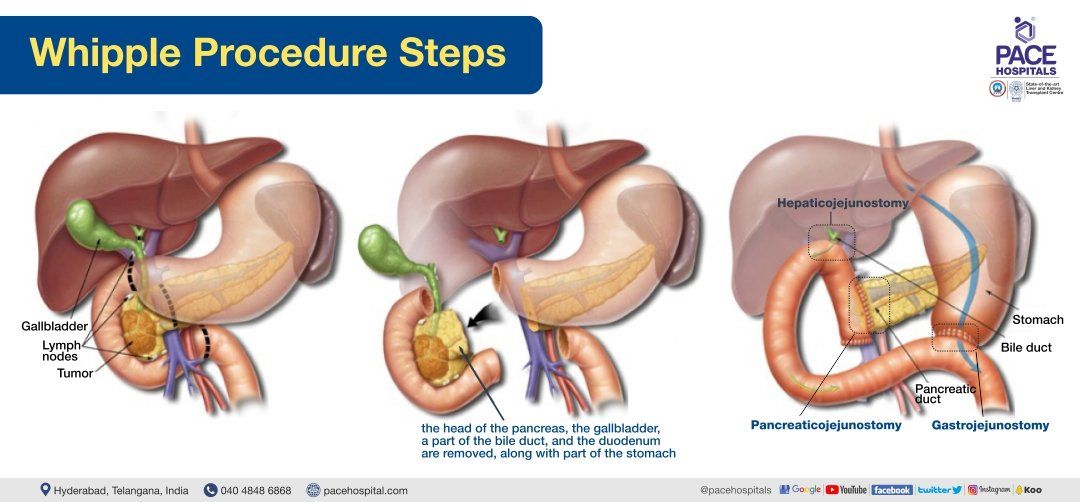
What should a patient expect after Whipple Surgery?
After surgery, the patient will be shifted to the recovery room for monitoring for 6 to 8 hrs after the surgery. As Whipple surgery is a complex surgery, a patient's recovery could take time, and he must go through intense precautions under doctor supervision.
Some of the situations patients can expect are:
- there will be a pain for a while after the procedure, which will be taken care of by experts, and any sign of infections and complications will be taken care of by them
- patients will be on a liquid diet for some time under the supervision of a doctor
- based on doctor advice, a patient can expect lung exercise (incentive spirometry) and movement in the room with the help of a nurse or physical therapist
-
Is Whipple procedure an open or minimally invasive surgery?
Usually, the Whipple procedure is open surgery. Still, based on the review and evaluation of several factors and the patient's health condition, the surgery could be robotic or laparoscopic, a minimally invasive type.
-
What are the advantages of the Whipple procedure?
Whipple procedure is the only successful surgery available for pancreatic cancer. When it was introduced, it had around a 25% death rate, but with advancements in diagnosis, surgical techniques, and postoperative care, date rates have reduced to 1-4%, provided surgery has been carried out by an experienced surgeon in equipped hospitals with a track record of 15-20 surgery per year.
Usually, only 8.5% of pancreatic cancer patients survive for five years, and the Whipple surgery increases the chance by 25%.
-
How long is the whipple procedure?
The Whipple procedure is a major abdominal surgery, it is a complex and complicated operation. The usual duration of surgery lasts anywhere between 4 to 6 hrs when done by open surgery and when it's done by laparoscopy or robotic surgery, it can last anywhere between 6 to 9 hours. Obviously, the technical difficulty and the time taken depends on the expertise of the surgeon, the built of the patient like obese or thin patient, the type of tumor such as how locally advanced and how easy it is to remove. All these factors determine the surgery, the whipples procedure is a time taking surgery so a thorough preoperative evaluation to assess the fitness of the patient has to be done before doing the Whipple procedure.
-
Who invented the whipple procedure?
Dr. Allen Oldfather Whipple, an American surgeon was the first to carry out this procedure in 1935; based on his name, it got its name "Whipple Procedure".
Frequently asked questions:
What could be the complication & risks associated with the Whipple procedure?
It's always advisable that the patients with pancreatic cancer thoroughly research the surgeon and hospital experience with the Whipple surgery. Whipple surgery is complicated and often includes open surgery, so there are risks during and after the surgery. In case of doubt, it is always wise to take a second opinion.
Some of the risks associated with the Whipple procedure during & after could be:
- Infection of the incision area or inside your abdomen
- Leaks can occur from the pancreatic and the bile duct anastomosis, which can lead to internal infections
- Bleeding at surgery area
- Delayed gastric emptying / Difficulty digesting some foods
- Problems with the fistulas
- Diabetes (could be temporary or permanent)
- Bowel changes
- Constipation
Is the Whipple procedure done laparoscopically?
Yes, the whipples procedure can be done laparoscopically or robotically, but we do it in very selected patients, patients who are fit for surgery per se because the whipples is a very major cancer surgery which takes about 4 to 6 hours. The laparoscopic pancreatectomy obviously prolongs the time, and so only patients who are young and very fit were not very obese who can tolerate a slightly more prolonged surgery are fit for laparoscopic or robotic pancreatectomy surgery.
What questions should patients ask when deciding whether to move forward with Whipple surgery?
As Whipple surgery is a complicated surgery and most often requires open surgery, a patient recommended for it should always cross-check and verify some of the questions with hospital management and surgeon before proceeding.
Some of the crucial questions are:
- What is the total no of Whipple procedures performed in a year?
- What is your success rate?
- What will my recovery be like?
- How is it going to benefit me?
- What kind of team do you have to support me during and after the surgery?
- What level of coordination do you maintain with medical and radiologists to develop patient treatment plans?
What should be my diet after the Whipple procedure?
You will be on a clear, liquid diet in the days after the Whipple operation. Your surgeon will decide when you are ready to introduce solid foods. For a while, you will want to eat soft, easily digestible foods. Talk to your healthcare provider about the foods they recommend.
When should I contact my surgeon in case of any discomfort after Whipple surgery?
In the following cases, you should immediately check with your concerned surgeon
- Your stitches get loose, or they open
- You develop a fever
- Your incision looks red, feels warm, leaks pus or hurts worse
- Your bowel movements are irregular
What is the life expectancy after a whipple procedure?
The Whipple procedure is obviously a very major abdominal surgery. It has its own risk of surgery. The early postoperative mortality is about 2 to 3%. That means out of 100 whipples surgery, about two or three or sometimes 5 patients or that would die in the early postoperative due to the complications of the surgery. But once patients are beyond the early postoperative phase, about two weeks or 14 days after surgery, the long-term quality of life and outcomes are excellent further patient can get back to his normal life and physical activity, he can eat and drink everything without any problems. Usually these patients will put them on pancreatic enzymes, supplements and calcium which are basically supplements, not even medicines. So other than taking these supplements and coming for regular checkups, the quality of life expectancy after Whipples procedure in long-term looks very good.
The other question that comes to mind is what are the long term outcomes of the patient after Whipple surgery? That means how many years do they survive?
Obviously, Whipple surgery is most of the time done for cancer and the long term outcomes are determined by the stage of the cancer. Patient can have stage one to stage four. Usually stage four we don't do surgery, but stage one to three. As a stage increases, the outcomes worsen likewise and depends upon: Do patient have vascular involvement? Is there lymphatic involvement? Are there lymph nodes involved? What is the grade of tumor? Is it a very aggressive kind of tumor or a less aggressive tumor? What is the grade of the tumor and also the type of the tumor?
Some tumors like neuroendocrine tumors, have better outcomes than adenocarcinoma. Overall as a group, if you look at the pancreatic and periampullary cancers for which the whipples surgery is done, the carcinoma head of the pancreas and the bile duct tumors have a poor prognosis. The five-year survivals are about 50% in these group of tumors while the other periampullary tumors in fact which are more common in India the duodenal tumors, the ampullary and the neuroendocrine tumors which they have usually very good outcomes and five year survival rate is about 70 to 80% in India for these groups.
What is the Whipple surgery cost in India?
Approximate cost for Whipple Surgery in India is Rs. 5,25,500 (five lakh twenty-five thousand five hundred only). However, cost of Whipple Procedure in India vary depending upon the multiple factors such as diagnostics, in-patient admission, patient condition, cancer stage, insurance approval for cashless facility, corporate policy, CGHS, EHS, ESI etc.
What is the cost of Whipple surgery in Hyderabad?
Whipple Surgery cost in Hyderabad ranges vary from Rs. 4,25,000 to Rs. 6,50,000 (four lakh twenty-five thousands to six lakh fifty thousands). However, cost of Whipple Procedure in Hyderabad vary depending upon the multiple factors such as diagnostics, in-patient admission, patient condition, stage of cancer, insurance approval for cashless facility, corporate policy, CGHS, EHS, ESI etc.
Our Locations
Subscribe to our newsletter and stay updated with the latest health information.
By clicking on subscribe now, you accept to receive communications from PACE Hospitals on email, SMS and Whatsapp.
Subscribe to PACE Hospitals News
Thank you for subscribing. Stay updated with the latest health information.
Oops, there was an error. Please try again submitting your details.
-

Payment in advance for treatment (Pay in Indian Rupees)
For Bank Transfer:-
Bank Name: HDFC
Company Name: Pace Hospitals
A/c No.50200028705218
IFSC Code: HDFC0000545
Bank Name: STATE BANK OF INDIA
Company Name: Pace Hospitals
A/c No.62206858997
IFSC Code: SBIN0020299
Scan QR Code by Any Payment App (GPay, Paytm, Phonepe, BHIM, Bank Apps, Amazon, Airtel, Truecaller, Idea, Whatsapp etc)
Call us at 04048486868
ADDRESS
PACE Hospitals
Hitech City : Beside Avasa Hotel, Pillar No. 18, Hyderabad - 500081
Madinaguda: Mythri Nagar, Beside South India Shopping, Madinaguda, Hyderabad - 500050
QUICK LINKS
Disclaimer
General information on healthcare issues is made available by PACE Hospitals through this website (www.pacehospital.com), as well as its other websites and branded social media pages. The text, videos, illustrations, photographs, quoted information, and other materials found on these websites (here by collectively referred to as "Content") are offered for informational purposes only and is neither exhaustive nor complete. Prior to forming a decision in regard to your health, consult your doctor or any another healthcare professional. PACE Hospitals does not have an obligation to update or modify the "Content" or to explain or resolve any inconsistencies therein.
The "Content" from the website of PACE Hospitals or from its branded social media pages might include any adult explicit "Content" which is deemed exclusively medical or health-related and not otherwise. Publishing material or making references to specific sources, such as to any particular therapies, goods, drugs, practises, doctors, nurses, other healthcare professionals, diagnoses or procedures is done purely for informational purposes and does not reflect any endorsement by PACE Hospitals as such.

